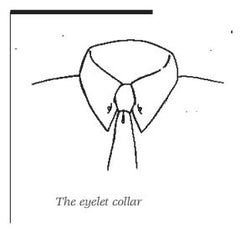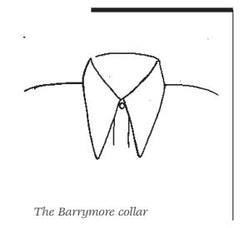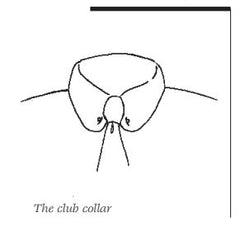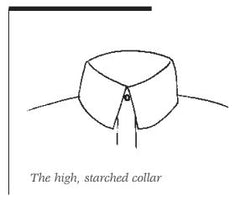History of Shirts
Posted by ADOLFO M

We have no idea which of our prehistoric ancestors first cut a hole in a skin, thrust his head through it and shouted “Eureka, I have a shirt!” But we do know that this is how shirts were worn until the late 1800’s, when shirts that opened down the front were introduced.
Legend has it that sometime in the 1820’s a Mrs.Montague of Troy, New York, cut her husband’s collar from his shirt, washed it, and reattached it with strings. In one fell swoop she had cut her laundry load in half, created the detachable collar, and sent her husband into the world with the cleanest collar on the dirtiest shirt in Troy. And she certainly started a trend. In fact, the detachable collar is still in use today, primarily in formal wear. In the 1900’s these collars were made of every conceivable material, including paper, cloth and celluloid, and all had one characteristic in common — starch, as much as the material could hold, transforming them into a form of self-torture. A soft attached collar was available then, but the “macho men” of that era scorned the wimpy comfortable soft collar and suffered in dumb silence. One particularly popular style was the stiffly starched lay-down collar popularized by the newspaper serial character Buster Brown in the early 1900’s.
A soft attached collar was available then, but the “macho men” of that era scorned the wimpy comfortable soft collar and suffered in dumb silence. One particularly popular style was the stiffly starched lay-down collar popularized by the newspaper serial character Buster Brown in the early 1900’s.
The wing collar, as we know it today, is a direct descendant of these early stand up collars. It was a standing collar with pointed turned-back tabs, and was worn for formal day or evening dress beginning in the 1880’s. It is still in fashion for formal wear today. We can say that the wing collar was the first phase of the lay down collars.
Sometime in the early 1920’s, an unsung hero threw away his instrument of torture and replaced it with a soft attached collar, starting a veritable fashion avalanche, as his long-suffering brothers followed suit. White collars and cuffs had also lost some of their luster and were being replaced by shirts with matching collars and cuffs. In a short time,men’s shirt fashions went from one basic collar style to a huge selection of lay-down collars, some outlandish and short-lived, but others which endure today. The process of fusing the collars (the use of a specially prepared interlining which is laminated to the outer layers of the collar to eliminate wilting and shrinking), was started in the 1920’s. This process is still used today on finely made stock shirts.
The pinned or eyelet collar was most popular during the late 20’s and early 30’s. The pin pierced the fabric, pulling the wings of the collar together, raising the tie. Later, a collar bar was substituted for the pin. Simply clipped or slid on the edges of the collar, the bar pulled the collar together in the same manner. Its offshoot, the tab collar, became popular in the late 20’s, using tabs that fasten under the tie with a brass stud to lift the tie. This style has a proved to be remarkable resilient, enjoying resurgences in the 30’s, in the 60’s and again in the 90’s.
This style has a proved to be remarkable resilient, enjoying resurgences in the 30’s, in the 60’s and again in the 90’s.
Slotted collars were invented by putting slots on the underside of the collar to hold tiny celluloid collar stiffeners (today’s plastic collar stays),which kept the collar in shape.
The button-down collar (a style in which the two collar points are held in place by small buttons) was developed by necessity, rather than as a fashion statement, in the early 1900’s. It seems that the landed gentry in England found the flopping of collars during polo matches a “damnable nuisance” and decided to “button them down” to get them out of the way. In the process they created one of the most popular and enduring of collars. It was rediscovered in the early 30’s and has been in vogue ever since.
In the process they created one of the most popular and enduring of collars. It was rediscovered in the early 30’s and has been in vogue ever since.
Straight collars have been with us since the 20’s and caused little excitement from one year to the next. The only changes they underwent were dull lengthening or shortenings of the collar. The longest collar was the “Barrymore,” named for the actor, who wore his points 41 /2" to 5" long. The most popular length in the 20’s and 30’s was 3 to 31/4" which is the most popular length once again today.
Enamored as the fashion world has always been of all things English, it’s not surprising that the spread collar was created to accommodate the Duke Windsor’s thick tie knot, the Windsor knot of the same name. When the Duke wore a tab collar on a visit to the U.S., it became the rage. The club, or rounded, collar, inspired by the starched white linen, wide, lay-down collar with round corners worn by the Eton schoolboys, also became popular in the 30’s.The 40’s meant war time. That meant men in uniforms. Consequently, men’s fashion changes were minimal.
The club, or rounded, collar, inspired by the starched white linen, wide, lay-down collar with round corners worn by the Eton schoolboys, also became popular in the 30’s.The 40’s meant war time. That meant men in uniforms. Consequently, men’s fashion changes were minimal.
The 50’s brought the lower-slope, shorter, more comfortable and conservative collars into popularity—but the basic collar styles of the 30’sand 40’s stayed, especially straights, spreads, modified spreads, tabs, eyelets and button-downs.
The 60’s saw the “JFK” look of modified-spread collars come into popularity. Again the public took on the look of a popular leader — this time an American.
High, long and spread collars were in vogue in the 70’s,as were tapered, brightly colored shirts.
The 80’s brought back the shorter and more conservative looks of the 50’s. The white collar and cuff was back, using both solids and patterns which complemented the contrast.Today’s collar styles are, historically speaking, moderate.The 3 to 31/4" point is again popular and styles are classic:button downs, straights, spreads and tabs are all in style.Freedom of fashion for men is the newest trend for the 90’s.Conservatism is giving way to fashion in the office. Men have more options in their dress code, especially with shirts and ties.The still-popular gray and blue suits are being joined by earth tones and, in addition to the always correct blues and whites, the wardrobe is being enhanced with shirts in greens, lavenders, pinks and creams. Stripes have become multi-colored as well as one color on white. French cuffs are increasingly popular and contrasting collars and cuffs are going strong. Collar variety is being used to give a suit a fresh look, even with a basic white shirt wardrobe.
As many of our customers have learned, a man can add new life to a suit simply by changing the style and/or color of his shirt. The shirt maker’s challenge today is to satisfy the customer’s wish for a varied selection. Today’s man is demanding options!
At that time, shirts, with their high, starched white collars and cuffs were more than an item of apparel. They were also a mark of class distinction.  Only those who did not do manual labor—“white-collar workers”—or the landed gentry, business owners, and royalty, were in a position to wear these white collars and cuffs. Quite simply, their day-to-day activities did not get them dirty and, when they did, they could afford to have them laundered.
Only those who did not do manual labor—“white-collar workers”—or the landed gentry, business owners, and royalty, were in a position to wear these white collars and cuffs. Quite simply, their day-to-day activities did not get them dirty and, when they did, they could afford to have them laundered.
From then on, the history of shirts becomes primarily the history of collar styles. It is the most important element of the shirt, the one first noticed, the one that gives a shirt its character and, not surprisingly, it is the one that has undergone the most change. Only those who did not do manual labor—“white-collar workers”—or the landed gentry, business owners, and royalty, were in a position to wear these white collars and cuffs. Quite simply, their day-to-day activities did not get them dirty and, when they did, they could afford to have them laundered.
Only those who did not do manual labor—“white-collar workers”—or the landed gentry, business owners, and royalty, were in a position to wear these white collars and cuffs. Quite simply, their day-to-day activities did not get them dirty and, when they did, they could afford to have them laundered.Legend has it that sometime in the 1820’s a Mrs.Montague of Troy, New York, cut her husband’s collar from his shirt, washed it, and reattached it with strings. In one fell swoop she had cut her laundry load in half, created the detachable collar, and sent her husband into the world with the cleanest collar on the dirtiest shirt in Troy. And she certainly started a trend. In fact, the detachable collar is still in use today, primarily in formal wear. In the 1900’s these collars were made of every conceivable material, including paper, cloth and celluloid, and all had one characteristic in common — starch, as much as the material could hold, transforming them into a form of self-torture.
 A soft attached collar was available then, but the “macho men” of that era scorned the wimpy comfortable soft collar and suffered in dumb silence. One particularly popular style was the stiffly starched lay-down collar popularized by the newspaper serial character Buster Brown in the early 1900’s.
A soft attached collar was available then, but the “macho men” of that era scorned the wimpy comfortable soft collar and suffered in dumb silence. One particularly popular style was the stiffly starched lay-down collar popularized by the newspaper serial character Buster Brown in the early 1900’s.The wing collar, as we know it today, is a direct descendant of these early stand up collars. It was a standing collar with pointed turned-back tabs, and was worn for formal day or evening dress beginning in the 1880’s. It is still in fashion for formal wear today. We can say that the wing collar was the first phase of the lay down collars.
Sometime in the early 1920’s, an unsung hero threw away his instrument of torture and replaced it with a soft attached collar, starting a veritable fashion avalanche, as his long-suffering brothers followed suit. White collars and cuffs had also lost some of their luster and were being replaced by shirts with matching collars and cuffs. In a short time,men’s shirt fashions went from one basic collar style to a huge selection of lay-down collars, some outlandish and short-lived, but others which endure today. The process of fusing the collars (the use of a specially prepared interlining which is laminated to the outer layers of the collar to eliminate wilting and shrinking), was started in the 1920’s. This process is still used today on finely made stock shirts.
The pinned or eyelet collar was most popular during the late 20’s and early 30’s. The pin pierced the fabric, pulling the wings of the collar together, raising the tie. Later, a collar bar was substituted for the pin. Simply clipped or slid on the edges of the collar, the bar pulled the collar together in the same manner. Its offshoot, the tab collar, became popular in the late 20’s, using tabs that fasten under the tie with a brass stud to lift the tie.
 This style has a proved to be remarkable resilient, enjoying resurgences in the 30’s, in the 60’s and again in the 90’s.
This style has a proved to be remarkable resilient, enjoying resurgences in the 30’s, in the 60’s and again in the 90’s.Slotted collars were invented by putting slots on the underside of the collar to hold tiny celluloid collar stiffeners (today’s plastic collar stays),which kept the collar in shape.
The button-down collar (a style in which the two collar points are held in place by small buttons) was developed by necessity, rather than as a fashion statement, in the early 1900’s. It seems that the landed gentry in England found the flopping of collars during polo matches a “damnable nuisance” and decided to “button them down” to get them out of the way.
 In the process they created one of the most popular and enduring of collars. It was rediscovered in the early 30’s and has been in vogue ever since.
In the process they created one of the most popular and enduring of collars. It was rediscovered in the early 30’s and has been in vogue ever since.Straight collars have been with us since the 20’s and caused little excitement from one year to the next. The only changes they underwent were dull lengthening or shortenings of the collar. The longest collar was the “Barrymore,” named for the actor, who wore his points 41 /2" to 5" long. The most popular length in the 20’s and 30’s was 3 to 31/4" which is the most popular length once again today.
Enamored as the fashion world has always been of all things English, it’s not surprising that the spread collar was created to accommodate the Duke Windsor’s thick tie knot, the Windsor knot of the same name. When the Duke wore a tab collar on a visit to the U.S., it became the rage.
 The club, or rounded, collar, inspired by the starched white linen, wide, lay-down collar with round corners worn by the Eton schoolboys, also became popular in the 30’s.The 40’s meant war time. That meant men in uniforms. Consequently, men’s fashion changes were minimal.
The club, or rounded, collar, inspired by the starched white linen, wide, lay-down collar with round corners worn by the Eton schoolboys, also became popular in the 30’s.The 40’s meant war time. That meant men in uniforms. Consequently, men’s fashion changes were minimal.The 50’s brought the lower-slope, shorter, more comfortable and conservative collars into popularity—but the basic collar styles of the 30’sand 40’s stayed, especially straights, spreads, modified spreads, tabs, eyelets and button-downs.
The 60’s saw the “JFK” look of modified-spread collars come into popularity. Again the public took on the look of a popular leader — this time an American.
High, long and spread collars were in vogue in the 70’s,as were tapered, brightly colored shirts.
The 80’s brought back the shorter and more conservative looks of the 50’s. The white collar and cuff was back, using both solids and patterns which complemented the contrast.Today’s collar styles are, historically speaking, moderate.The 3 to 31/4" point is again popular and styles are classic:button downs, straights, spreads and tabs are all in style.Freedom of fashion for men is the newest trend for the 90’s.Conservatism is giving way to fashion in the office. Men have more options in their dress code, especially with shirts and ties.The still-popular gray and blue suits are being joined by earth tones and, in addition to the always correct blues and whites, the wardrobe is being enhanced with shirts in greens, lavenders, pinks and creams. Stripes have become multi-colored as well as one color on white. French cuffs are increasingly popular and contrasting collars and cuffs are going strong. Collar variety is being used to give a suit a fresh look, even with a basic white shirt wardrobe.
As many of our customers have learned, a man can add new life to a suit simply by changing the style and/or color of his shirt. The shirt maker’s challenge today is to satisfy the customer’s wish for a varied selection. Today’s man is demanding options!